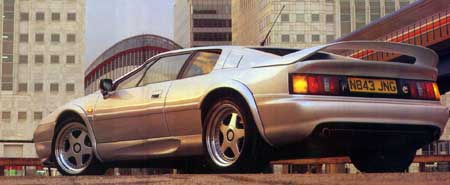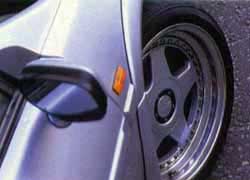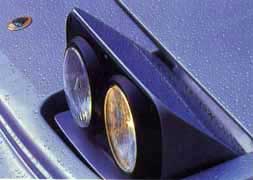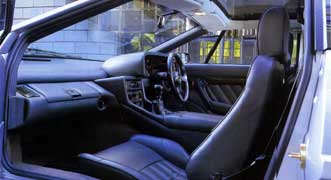

LOTUS
ESPRIT
AUTOCAR ROAD
TEST
Autocar
Magazine, August 1996
With all the hype surrounding the remarkable new Elise, it's easy to forget Lotus's other new car, the Esprit V8. It may not be quite as fresh to look at, the design has been around in one form or another for 21 years, but as far as the future of Lotus is concerned, its success is paramount. The engine alone is understood to have cost nearly £5.5 million in research and development fees, £1.5 more than the entire Elise budget. It's one of the main reasons that Lotus's finances are currently so shaky. If, however, it succeeds in rekindling the Esprit's dwindling flame, it will have been worth it. With the performance, efficiency and development potential to power a whole new range of 21st century sports cars, it could yet prove to be Lotus's lifeline to the future.
Performance & Brakes
For all the criticisms leveled at the Esprit, a shortage of performance has never been among them. The old turbocharged, intercooled 2.2-litre lump was pumping out 300bhp at the end of its life and rocketed an S4s from 0-60mph in 4.7sec and on to a top speed of 162mph.All the more impressive that the new 3.5-litre V8 engine manages to make even these figures look faintly pedestrian. The 3.5-litre all-aluminium V8 uses two low-pressure turbochargers running at 0.5bar to serve up 349bhp at 6000rpm. Take into account the extra weight of the V8 engine (around 50kg, according to Lotus) and the Esprit V8 can count on a power-to-weight ratio of 260bhp per tonne, more than any other rival bar the monstrous TVR Cerbera.
It's an advantage that the Lotus makes full use of, streaking to 60mph from rest in 4.2sec and on to 100mph 6.1sec later. On the way it collects the scalps of the Porsche Carrera 2, Chrysler Viper and Honda NSX, not to mention the vastly more expensive Ferrari F355. That's an impressive tally by anybody's reckoning, even if its 172mph top speed is slightly down on the last's 173mph.
The key to this extraordinary performance is the colossal mid-range pull of the V8 engine. Maximum torque of 295lb ft comes into play at 4250rpm but, judging by the car's gutsy fifth gear performance, most of that is available from 2500rpm onwards. Let the engine fall below this speed and it still feels a bit flat as the turbos start to gather speed. The absurd all-or-nothing kick of the highly strung four is long gone, but the V8 still lacks the instantaneous throttle response and ever-increasing thrust of the best naturally aspirated engines. Down-changing requires a deliberate prod of the throttle and a carefully timed gearchange rather than a quick blip followed by a flick of the lever.
The aral enticement is the engine's only other disappointment. The flat-plane crankshaft design robs it of the usual V8 burble, while the turbochargers and stringent drive-by noise regulations prevent production Esprits from making up for the lack of quality with outright quantity. A better-sounding after-market sports exhaust is available from Lotus dealers for £393.
The Renault-sourced gearbox cannot be so easily remedied. A new twin-pate AP racing clutch, which reduces pedal effort, and softer springs in the gear selector will soon become standard on production Esprits, but our car came with an intermediate solution which still left a number of question marks hanging over the car's driveability. The ventilated disc brakes, by contrast, are something of a revelation. The pedal travel may be a little too short for progressive low-speed braking, but the new Kelsey Hayes three-channel anti-lock controller is far superior to the old system, allowing maximum retardation before cutting in.
Massive power only slightly marred by heavy gearchange and tame sound ••••
Handling & Ride
What separates the Esprit from any other supercar is its steering. How Lotus manages to engineer a power steering system that requires so little effort, yet retains a level of speed, delicacy and feel that is beyond the reach of all bar unassisted lightweight specials such as the Lotus Elise and Caterham 7, remains a mystery. Step back into any saloon after a day with the Esprit V8 and you'd swear that someone had replaced the steering rack with a rubber one, so sloppy and lethargic are its responses.Fears that Lotus might be asking a bit too much of its ageing steel backbone chassis have not yet surfaced. The new V8 powerplant may be the heaviest and most powerful engine ever fitted, but the Lotus engineers have managed to preserve the extraordinary balance and agility of the four-cylinder car.
Cornering grip, fro the chunky 285/35, rear tyres is huge, particularly in very fast, sweeping curves, while booting the tail out wide in a second-gear hairpin feels safe, easy and natural.
Even without these tail-out antics, the Esprit is a rewarding car to drive quickly. Where a TVR Cerbera intimidates, the Esprit reassures, flattering drivers with its confidence-building steering, straight-line stability and virtually roll-free cornering.
Given the size of the tyres, it is not surprising to learn that the Esprit kicks and thumbs a bit over high-frequency bumps such as potholes or Cat's-eyes, but rarely is this enough to throw the car off line. Lower-frequency irregularities are treated with even more disdain, shrugging off crest the dips with an immaculate display of body control and damping.
The Lotus is rather less appealing as an everyday prospect. The appalling rear visibility, heavy clutch, limited ground clearance and reflective front windscreen make low-speed manoeuvres a challenge that we would rather live without.
This Esprit proves that Lotus is still the best chassis builder around ••••
Economy
The Esprit V8 is not a car you expect much in the way of economy from. And so it is. Drive it as it should be driven and consumption drops well below 20mpg, hence the poor 16.5mpg we recorded overall, which puts it roughly on a par with the TVR Cerbera and well ahead of the Chrysler Viper, but some way below the Porsche 911.However, being turbocharged, the situation improves markedly with a more cautious approach. You can drive it down a flat motorway at 80mph without using any boost. Witness the vaguely respectable 22.1mpg it managed over our economy route. On the 72-litre tank it is feasible to put 850 miles between fills, although realistically the range is nearer 300 miles.
Although Esprit V8 drivers probably won't car much, economy isn't too bad ••
Market & Finance
The enormous publicity surrounding the Elise and the V8 engine has sparked renewed interest in Lotus. Most dealers have a couple of Esprit V8s on order, with trade-ins coming from Porsche, Toyota and even Ferrari.Whether this enthusiasm will last is harder to divine. A number of Esprit buyers have clearly been holding back waiting for the V8 to arrive, resulting in a blip in the sales charts. Concerns over the long-term stability of Lotus may also make potential owners think twice before investing the best part of £60,000 in one of its products.
Prices of good used Esprits have been quite strong of late, but don't expect the V8 to be treated any more kindly by the trade. An Esprit will never have the blue-chip trade-in value of a Porsche 911 or Ferrari F355, whatever engine is in the back.
Trade-in won't match the big names, despite wave of enthusiasm for new V8 ••



Design & Engineering
For 21 years the Esprit's old slant-four powerplant struggled to live up to its dramatic supercar styling. Now, with a brand new top-drawer V8 behind the seats, the tables are turned.But apart from one extra exhaust pipe, a slightly revised front air dam and tiny 'V8' badges, Lotus has done nothing to distinguish the new 3.5-litre flagship from its 2.2-litre four-cylinder S4s predecessor.
Of course, new engines don't come cheap, and Lotus also has the radical Elise to pay for, so a new body for the Esprit would have proved far too expensive. However, a few low-budget styling tweaks – perhaps a new rear wing or fixed, faired-in headlamps – would have better signaled the latest Esprit's mechanical credentials.
Curiously, Lotus unveiled the V8 with gorgeous and distinctive six-spoke alloy wheels, but these have disappeared without a trace – our test car was fitted with S4s's OZ Racing split rims.
Nevertheless, familiar or not, the Esprit's aggressive, low-slung proportions still turn heads like few others. And – as composite cars go – its body is very well put together, with wide but even panel gaps, excellent paintwork and ripple-free contours.
The same can't be said of the dated interior, though. It features a mix of high-quality hide, clumsy timber, self-tapping screws and nasty out-sourced parts. And it squeaks and rattles at the slightest provocation.
Developed in only 27 months by a core team of just four gifted engineers with only £5million to spend, the new jewel in the Esprit's old crown is – as the badges suggest – its in-house designed 90deg twin-turbo V8 engine. Packed with innovative engineering, the new powerplant is only 15 per cent heavier than the old four-pot – thanks to precision thin-wall alloy castings – and so compact that it actually liberates luggage space.
In pure engineering and supercar credibility terms, the Lotus Esprit is, at last, complete – just don't expect anyone to notice.
V8 just what Esprit needed, but a few styling tweaks would have been welcome •••

Comfort, Equipment & Safety
The interior of the Esprit is the biggest giveaway to its '70s origins. The angular shapes, slab-like windscreen, hopeless rear visibility and poor ergonomics all smack of a bygone era. The excessive wind the tyre noise, not to mention the slight resonance and pedal vibration at around 5000rpm, also point to a lack of modern day refinement.The driving position is fine if you are exactly 5ft 8in, but larger drivers bemoan the uncomfortably long seat squab and fixed position steering. The gray leather that covers most of the cabin is not of the best quality and highlights the slightest tremor with its continual creaking. In common, with other low-volume manufacturers, the Esprit does without airbags and pre-tensioned seatbelts, but the powerful anti-lock brakes are a huge bonus. Basic but effective air conditioning, a lift-out glass sunroof and electric windows are the only other luxuries that come as standard.
'70s throwback interior uncomfortable for many, Safety equipment limited ••
Autocar Verdict
After waiting so long for an engine worthy of the Esprit's talented chassis, it seems churlish to be anything other than delighted by the new home-grown Lotus V8. Apart from its disappointing noise and slightly lethargic throttle response, this engine is an extremely impressive piece of engineering. It's smooth, efficient and very powerful. And being a modular design, it can also be adapted to make a V6, a straight four or even a V4 if Lotus so wishes.In its current V8 form, it takes up no more room than the old four-cylinder unit, barely uses any more fuel and churns out a whole lot more power and, therefore, performance. In one step it has transformed the Esprit from a very quick car into a staggeringly quick one and secured it an on-going place in the increasingly rarefied world of the supercar. For this alone Lotus deserves our sincerest congratulations.
However, we also have grave reservations over the Esprit V8. Providing speed entirely commensurate with a supercar costing nearly £60,000 is one thing; creating a similarly exotic environment in which it can be enjoyed is another and here the Esprit falls down badly. In its driving position, dated and scrappy cabin, poor ergonomics and improved but still disappointing gearchange, the Esprit has too many cracks between its headline talents.
A Porsche 911 Carrera costs almost the same and while it may not posses quite the same visual or dynamic drama, it provides most of the thrills of an Esprit with an integrity that leaves the Lotus looking overpriced.
Anyone who is prepared to accept these limitations will still discover a rare driving experience in the Esprit V8. It is as fast, agile and entertaining as any other car in its price range, and its handling remains a unique joy in the right circumstances. But it will take a new body, interior and drivetrain before the Esprit's impressive engine and fine chassis will be brought to the public acclaim that, in isolation, they deserve. Whether Lotus will ever be able to afford such an expense in its current state is another matter. We await the forthcoming weeks with interest and more than a little apprehension.
A fine driver's car with too many flaws •••
Specification
ENGINE
Layout: 8 cyl in vee, 3506cc
Max power: 349bhp @ 6500rpm
Max torque: 295lb ft @ 4250rpm
Specific output: 100bhp per litre
Power to weight: 260bhp per tonne
Torque to weight: 220lb ft per tonne
Installation: Mid, longitudinal, rear-wheel drive
Construction: aluminium alloy head and block
Bore/stroke: 81/83mm
Valve gear: 4 valves per cyl, dohc
Compression ratio: 8.0:1
Ignition and fuel: electronic ignition, Lotus-designed engine management, twin Garrett T25 turbochargersMAXIMUM SPEEDS
5th gear: 172mph/6750rpm, 4th: 129/7200, 3rd: 96/7200, 2nd: 65/7200, 1st: 40/7200ACCELERATION
0-30mph: 1.7 sec
0-60mph: 4.2 sec
0-100mph: 10.3 sec
0-140mph: 22.0 secACCLERATION IN 3rd GEAR
30-50mph: 3.0
40-60mph: 2.7
50-70mph: 2.7
60-80mph: 2.9Standing quarter mile: 12.8sec/110mph
Standing Kilometre: 22.7sec/142mph
30-70mph through gears: 4.0secGEARBOX
Type: 5-speed manual
Ratio/mph per 1000rpm
1st 3.36/5.5, 2nd 2.05/9.0, 3rd 1.38/13.4
4th 1.09/17.9, 5th 0.76/2.25, Final drive ratio: 3.89:1BRAKES
Front: 296mm ventilated discs
Rear: 300mm ventilated discs
Anti-lock: standardWEIGHT
Kerb weight: 1346kg
Distribution f/r: 43/57
Max payload 227kgSUSPENSION
Front: double wishbones, coil springs, anti-roll bar
Rear: upper and lower links, coil springs, anti-roll barSTEERING
Type: rack and pinion, power assisted
Turns lock to lock: 3.1WHEELS & TYRES
Wheel size: 8.5x17in (f), 10x18in (r)
Made of: aluminium alloy
Tyres: 235/40 ZR17 (f), 285/35 ZR18 (r)TECHNICAL LAYOUT
Body: 2dr coupe
Cd: n/a
Front/rear track: 1520/1520mm
Turning circle: 10.6m
Min/Max front leg room: 1060/1250mm
Max front head room: 880mm
Interior width: 1430mm
Min/Max boot width: 1240/1870mm
Loading height: 880mm
VDA boot volume: n/a
|
|